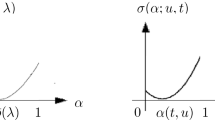Abstract
We study a totally asymmetric simple exclusion process where jumps happen at rate one, except at the origin where the rate is lower. We prove a hydrodynamic scaling limit to a macroscopic profile described by a variational formula. The limit is valid for all values of the slow rate. The only assumption required is that a law of large numbers holds for the initial particle distribution. This allows also deterministic initial configurations. The hydrodynamic description contains as an unknown parameter the macroscopic rate at the origin, which is strictly larger than the microscopic slow rate. The limit is proved by the variational coupling method.
Similar content being viewed by others
REFERENCES
S. A. Janowsky and J. L. Lebowitz, Finite size effects and shock fluctuations in the asymmetric simple exclusion process, Phys. Rev. A 45:618-625 (1992).
S. A. Janowsky and J. L. Lebowitz, Exact results for the asymmetric simple exclusion process with a blockage, J. Statist. Phys. 77:35-51 (1994).
T. Seppäläinen, Hydrodynamic scaling, convex duality, and asymptotic shapes of growth models, Markov Process. Related Fields 4:1-26 (1998).
P. Covert and F. Rezakhanlou, Hydrodynamic limit for particle systems with nonconstant speed parameter, J. Statist. Phys. 88:383-426 (1997).
T. M. Liggett, Stochastic Interacting Systems: Contact, Voter and Exclusion Processes (Springer-Verlag, New York, 1999).
C. Landim, Hydrodynamical limit for space inhomogeneous one-dimensional totally asymmetric zero-range processes, Ann. Probab. 24:599-638 (1996).
H. Rost, Non-equilibrium behaviour of a many particle process: Density profile and local equilibrium, Z. Wahrsch. Verw. Gebiete 58:41-53 (1981).
C. Kipnis and C. Landim, Scaling Limits of Interacting Particle Systems (Springer-Verlag, New York, 1999).
P. W. Glynn and W. Whitt, Departures from many queues in a series, Ann. Appl. Probab. 1:546-572 (1991).
T. Seppäläinen, Existence of hydrodynamics for the totally asymmetric simple K-exclusion process, Ann. Probab. 27:361-415 (1999).
J. F. C. Kingman, The ergodic theory of subadditive stochastic processes, J. Royal Stat. Soc. Ser. B 30:499-510 (1968).
L. C. Evans, Partial Differential Equations (American Mathematical Society, 1998).
D. Ostrov, Solutions of Hamilton-Jacobi equations and scalar conservation laws with discontinuous space-time dependence, preprint (1999).
T. Seppäläinen, Coupling the totally asymmetric simple exclusion process with a moving interface, Markov Process. Related Fields 4:593-628 (1998).
K. Johansson, Shape fluctuations and random matrices, Comm. Math. Phys. 209:437-476 (2000).
R. L. Wheeden and A. Zygmund, Measure and Integral (Marcel Dekker, 1977).
Author information
Authors and Affiliations
Rights and permissions
About this article
Cite this article
Seppäläinen, T. Hydrodynamic Profiles for the Totally Asymmetric Exclusion Process with a Slow Bond. Journal of Statistical Physics 102, 69–96 (2001). https://doi.org/10.1023/A:1026508625058
Issue Date:
DOI: https://doi.org/10.1023/A:1026508625058




